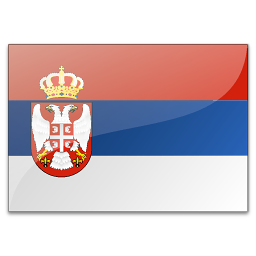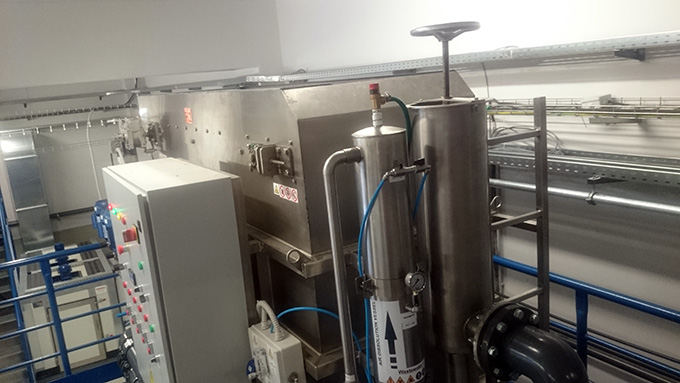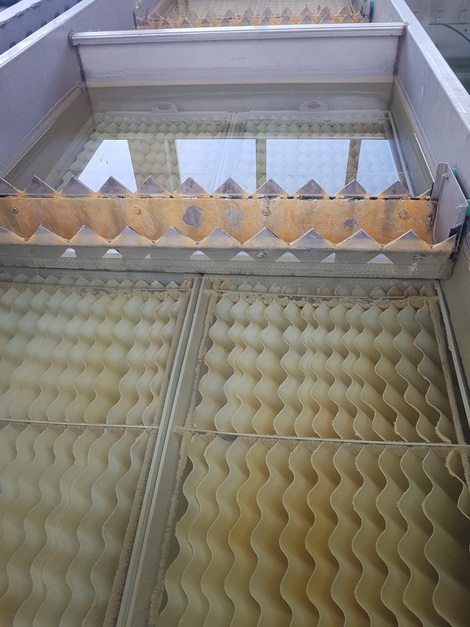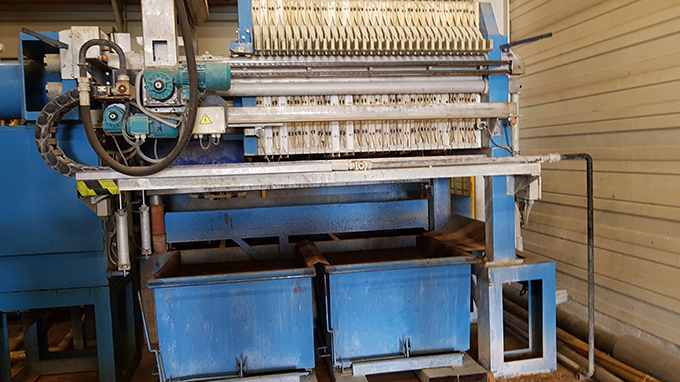VENTILATION AND PURIFICATION OF POLLUTED AIR IN INDUSTRY
We design, manufacture, install and put into operation devices and plants for purification of waste gases (waste air) from various technological processes such as:
- Galvanization, hot-dip galvanizing, dyeing
- Welding
- Metal processing (cutting, grinding, etc.)
- Recycling industry - sorting lines, plastic processing by extrusion, hot wash vapors, grinding and tearing - mills, etc.
- Incinerators of all types of waste
- Foundries
- Car paint shops
- Bakeries
- Coffee roasters
- Dryers for meat and other food industries
- Production of polyester and other resins
- Production for formulation of paints and varnishes
- Production for formulation of oils and lubricants
- Production for plastic processing, etc.

DEVICES AND SYSTEMS FOR WASTE AIR PURIFICATION
Purification of air from particles and gases
- CYCLON DEVICES - cyclones and multicyclones
Cyclones are devices that belong to the group of centrifugal separators of material particles from the air intake stream. They are usually used in the process of purifying the air before other devices. For higher flows, cyclones are packed in batteries - multicyclones.
- BAG FILTERS
Bag filters are made of fibers of different composition (natural and synthetic fibers) with metal housings. Filters of different capacity are made depending on the flow of waste air.
- DUSTERS

They are intended for removing particles from the waste air stream of cement plants, sugar factories, wood industry ...
- SCRUBERS (wet extractors): venturi scrubbers, scrubbers with filling, with neutralization.
Scrubbers are devices used in the treatment of air that is polluted with dust particles and harmful gases. They belong to the group of "wet air purifiers".
The principle of removing pollutants is based on the contact of the pollutant with a precisely defined tool that will react with the pollutant and reward the compound soluble in water. Contaminated air contact solutions can be water (for dust particles) or reagent solutions that act specifically on certain compounds present as pollutants in the air.
The degree of purification is improved by extending the retention time in the scrubber or by increasing the surface area of the solution contained in the scrubber by means of spray nozzles, filling placement (bodies of different shapes and dimensions) or aspirators. Scrubbers can also be used as apparatus for recirculating heat from hot gases by condensing gases. In that case, they are called "condensing purifiers".
They are used in almost all industrial gas purification systems (foundries, factories of basic and processing chemical industry, pharmaceutical industry, paint and varnish industry, pesticide production, treatment of hazardous and non-hazardous waste by chemical and metallurgical processes, animal waste incinerators, cattle farms, laying hens, chickens….)
Skruberi se mogu koristiti i kao aparati za recirkulaciju toplote iz toplih gasova kondenzacijom gasova. U tom slučaju se nazivaju „kondenzacioni prečistači“.
The advantages of using scrubbers are:
- Relatively low cost, and the efficiency of particle removal is higher than dry cleaners
- Special solutions allow the removal of particles with a diameter of 0.1 micrometer
- They can be used as air purifiers in systems where it is necessary to lower the gas temperature before final purification
- Suitable for the treatment of gases in flammable and explosive environments
- Simultaneously with the treatment of solid phases, they can purify both gas and liquid (vapor) phases



- VENTURI SCRUBERS
- SCRUBERS WITH COMBINED WATER AND AIR ABSORPTION - a special system enables the reduction of wastewater quantities
- ACTIVATED CARBON FILTERS
Activated carbon filters purify the air from volatile organic, acid gases, organic vapors and solvents, according to the principle of adsorption on activated carbon.
- DIGESTORS WITH WASTE AIR PURIFICATION SYSTEM - Digestors are working chambers that ensure that waste air (vapors, gases, dust, etc.) is removed from the work area. The purification system is a compact scrubber with neutralization. Advantages: efficient purification, small dimensions, suitable for laboratories, goldsmiths, etc.
Reference list of installed equipment for waste air treatment, see...
OTHER
- production of technical rubber products
- servicing and maintenance of plants for surface protection, water purification and polluted air purification
- activated carbon
- servicing of pumps
- servicing of filter presses, clothes
- servicing and maintenance

News
DAF DEVICES
DAF (Dissolved Air Flotation) device is used for separation of dispersed and suspended particles from wastewater. Flotation is a mechanical separation proccess based on making supersaturated air solution in wastewater, meaning that micro bubbles make contact and connect with suspended substances and enable them to reach the surface and float.The air is being dispersed from the bottom of the pool, t it “collects” particles on it’s way up and pushes them to the surface. Coagulant neutralizes the electrostatic load of colloid particles and enables their agglomeration into floccules. Polyelectrolyte connects the neutralized particles into even bigger floccules. Piping saturator has a unique construction and enables air bubbles with dimensions 10-70 micrometers, what provides an extraordinary efficiency. AREAS OF APPLICATION AND MAIN APPLICATIONS Milk industry, ice cream production, juice production, alcoholic beverages production, breweries, fish and meat processing, fruit and vegetables processing, drinking water, etc. Plastic recycling, chemical industry, oil and gas, textile industry, leather industry, laundry services, package washing etc. Advantages of our DAF Systems: - Very high level of reduction of pollution parameters Suspended substances Reduction rate from 90-99% Oils and fats Reduction rate trom 90-99% BPK5 Reduction rate from 70=80% HPK Reducstion rate from 70-80% - Comprehensive and efficient solution which provides high stability and efficient removing of dirt. Reliable method for refining of technological wastewater. - Simple installations provide compact equipment set and saves space. - Major savings because the system construction and technological parameters ensure small consumption of energy, air and chemicals. - Very stable functioning of coagulation, neutralization and flocculation systems. - Law level of turbulences, there is no re-retraction of floating sediments. - We have available a developed digital services package which provides follow-up and optimization of the DAF system long-distance working and remote controllie of thesystems. - Instead of classical lamellas, we use special “U” profiles which provide: Separated flowi of wastewater and clean water Equal distribution of wastewater flow and sectors load, decreasing the turbulence There is no obstruction of flow of flotants Flow leaders secure less consumption of polymers DAF is a device made of stainless steel We can deliver complete systems or rebuild and upgrade existing DAF devices.
Read more
TECHNOLOGICAL TREATMENT PLANT FROM BATTERY PRODUCTION AND RECYCLING WASTEWATER
Type of wastewater: technological wastewater from battery production and recycling Capacity: 700 m³/day, 29 m³/h Table 1: Types of wastewaters and damaging and dangerous substances generated during the production process Types of wastewater Origin Existing hazardous and dangerous matters Alkaline rinsing water Workspace and streets cleaning Lead and dust Sour rinsing water with high concentration Paste mixer and shepherd machine washing Pb, PbO2, PbSO4 Neutral concentrates Wet Ventures - scrubbers Pb, Sn, Sb, hydroxides Water from battery formulation Charging battery with acid Sulfuric acid Water from battery recycling Cutting and emptying of battery Sulfuric acid, Pb, PbO2, PbSO4 Outgoing water quality Purified wastewater from the treatment plant should satisfy the following limit values for discharing into the land waters (in this case a small river). Limit values are extremely low for some hard metals, which are contained in these wastewaters, such as: Cadmium – 0,1 mg/l Lead – 0,5 mg/l Iron – 2 mg/l Sulfates – 250 mg/l Suspended substances – 35 mg/l BPK5 – 25 mg/l HPK – 125 mg/l, etc. The investor’s request was to deliver a technological solution – Technology for wastewater processing through the project: machine, electro and measuring regulating equipment, electro-commanding cabinet with PLC and software, launching and a guarantee that the required parameters will be inside the limit values. Plant working regime: Continually (moze I : non-stop), 24h/7 daysOV generated during he production process are being treated trough three lines: Water line Dirt line Preparation and chemicals dosing line These technologies are being established on the water line: Egalisation Neutralisation Neutralisation II and removing of sulfates Coagulation Flocculation Sedimentation Clarification of sedimented water Final control These technologies are being established on the preparation and chemicals dosing line: Preparing a dosing solution Dosing the solution The system is completely automatized, with support of electro- commanding cabinet with SIEMENS PLC, software and measuring regulation equipment. After the equipment is delivered and the system is launched, chemical analysis of the purified OV have been done in an accredited lab. Those analysis showed that all parameters were inside the limit values.
Read more
MEMBRANE FILTER PRESSES
Filter plates at Mebrane filter press are equipped with membranes that enable additional "squeezing" -dehydration of the filter cake. Increasing the filling pressure ensures precompression and drainage of the filter cake in the chamber. When the filling pressure reaches a predetermined value (approximately 6-8 bar), the filter cake is additionally exposed to the membrane pressure, and additionally "squeezed". Elastic membranes, which can be made of polypropylene (PP) and synthetic rubber (NBR, EPDM), use compressed air to press the filter cake over the entire surface of the chambers. Additional compression thus expels free water through the filter cloth. ADVANTAGES OF MEMBRANE FILTER PRESSES: • More economical filtration due to high degree of drainage and shorter cycle time Maximum flexibility for expansion and automation possibilities Extended pump life in the case of abrasive media, due to low supply pressure CASE STUDY: Delivery of membrane filter press with the dimensions of plates 1000x 1000 mm, 36 plates, volume 770 liters, for filtering the solution of lead "paste" in the process of battery recycling. Investor "TAB MAK". The press is equipped with: membrane plates with EPDM membrane, system for automatic opening of plates, "Squezing" system for additional dehydration of filter cakes, "drip tray" system. Degree of dehydration of filter cakes: 80-90% dry matter..
Read more



